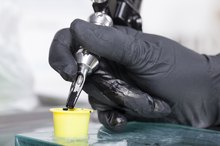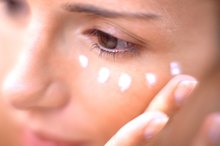How to Know if You're Allergic to Tattoo Ink
The process of getting a tattoo involves implanting pigments beneath layers of skin to create a design. For some people, this can cause an allergic reaction. The results of an allergic reaction to tattoo ink can be anything from irritation to total rejection of the ink, where the body rids itself of the ink particles by pushing them back through the skin. If you have never been tattooed before or are trying a new ink, it is best to check if you are allergic to the ink before your tattoo is started.
Visit your tattoo artist before getting tattooed 1. Shops in most states are required to keep a Material Safety Data Sheet (MSDS) for their ink, listing the ingredients of the tattoo ink. Make a copy of this ingredients list. If the MSDS is not available, write down the name of the manufacturer and the color of the ink so that the manufacturer can be contacted for an ingredients list. Make note of any substances that you are allergic to and ask for an alternative color if there are potential irritants in the ink.
How to Tell If You Have a Wasp Bite or Sting
Learn More
Have a patch test done with the ink at least 24 hours in advance. Place a small amount of tattoo ink on an area of bare skin at or near the tattoo site and allow it to remain for 24 hours. If there is a reaction to the ink such as itching or swelling, you may have an allergy to the ink.
Have your artist perform a "dot test" at least 24 hours before your tattoo is to be drawn. In this test, a small amount of pigment is tattooed into the skin as a small dot. Monitor the area carefully to see if there is any reaction or problems. Redness and swelling may indicate an allergy to the tattoo ink 1.
Tips
Redness and irritation is normal immediately after a tattoo is finished. If the area swells, becomes hot to the touch or you develop a fever, see a doctor immediately.
Related Articles
References
- Tattoo Info: Allergies
- Lynn C, Michaela, Herdrich D, et al. The evolutionary adaptation of body art: Tattoo as an honest signal of enhanced immune response in American Samoa. Amer J Hum Biol. 2019:e23347. doi:10.1002/ajhb.23347
- Wilson WT, O’Boyle M, Leach WJ. Unusual complication of a tattoo in an immunosuppressed patient. Case Reports 2018; 2018:bcr-2018-224968. doi:10.1136/bcr-2018-224968
- Oanţă A, Irimie M. Tinea on a tattoo. Acta Dermatovenerol Croat. 2016;24(3):223-4.
- Tohme RA, Holmberg SD. Transmission of hepatitis C virus infection through tattooing and piercing: a critical review. Clin Infect Dis. 2012;54:1167–1178. doi:10.1093/cid/cir991
- Centers for Disease Control and Prevention. HIV transmission. Updated August 6, 2019.
- Warshaw EM, Schlarbaum JP, Taylor JS, et al. Allergic reactions to tattoos: Retrospective analysis of North American Contact Dermatitis Group data, 2001-2016. J Am Acad Dermatol. 2019;2:e61-e62. doi:10.1016/j.jaad.2019.09.077
- Kirby W, Alston DB, Chen AH. The incidence of hypertrophic scarring and keloid formation following laser tattoo removal with a quality-switched Nd:YAG laser. J Clin Aesthet Dermatol. 2016;9(5):43–47.
- Islam PS, Chang C, Selmi C, et al. Medical complications of tattoos: A comprehensive review. Clin Rev Allergy Immunol. 2016;50(2):273-86. doi:10.1007/s12016-016-8532-0
- Valbuena MC, Franco VE, Sánchez L, Jiménez HD. Sarcoidal granulomatous reaction due to tattoos: report of two cases. An Bras Dermatol. 2017;92(5 Suppl 1):138–141. doi:10.1590/abd1806-4841.20175860
- Orzan OA, Popa LG, Vexler ES, Olaru I, Voiculescu VM, Bumbăcea RS. Tattoo-induced psoriasis. J Med Life. 2014;7 Spec No. 2(Spec Iss 2):65–68.
- Ross JR, Matava MJ. Tattoo-induced skin "burn" during magnetic resonance imaging in a professional football player: a case report. Sports Health. 2011;3(5):431–434. doi:10.1177/1941738111411698
- Kaur RR, Kirby W, Maibach H. Cutaneous allergic reactions to tattoo ink. J Cosmet Dermatol. 2009;8:295-300. doi:10.1111/j.1473-2165.2009.00469.x
- Brady BG, Gold H, Leger EA, Leger MC. Self-reported adverse tattoo reactions: a New York City Central Park study. Contact Dermatitis. 2015 Aug;73:91-99. doi:10.1111/cod.12425
- Forbat E, Al-Niaimi F. Patterns of reactions to red pigment tattoo and treatment methods. Dermatol Ther (Heidelb). 2016;6(1):13–23. doi:10.1007/s13555-016-0104-y
- Rosenbaum BE, Milam EC, Seo L, Leger MC. Skin care in the tattoo parlor: A survey of tattoo artists in New York City. Dermatology. 2016;232:484-489. doi:10.1159/000446345
- Khunger N, Molpariya A, Khunger A. Complications of tattoos and tattoo removal: Stop and think before you ink. J Cutan Aesthet Surg. 2015;8:30–36. doi:10.4103/0974-2077.155072
- United States Food and Drug Administration. Tattoos & permanent makeup; fact sheet. Oct 31, 2019.
Tips
- Redness and irritation is normal immediately after a tattoo is finished. If the area swells, becomes hot to the touch or you develop a fever, see a doctor immediately.
Writer Bio
Gwen Wark is a freelance writer working from London, Dublin, and New York. She has been a published writer since 1998 with works appearing in both university and local publications. Her current writing projects include SEO, web copy, print and advertising features. She holds a Bachelor of Arts in English with a minor in history from Rutgers University.









